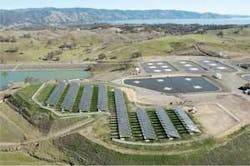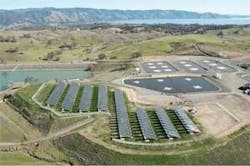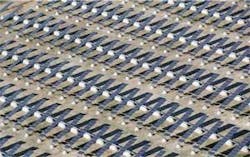Solar Installation Helps Offset Rising Energy Costs
By Debra Sommerfield
Two hours northeast of the San Francisco Bay Area, Lake County is an area known for its natural beauty, clean air, vineyards and Clear Lake, the largest natural lake entirely in California. Lake County is also known for its commitment to sustainability, demonstrated by the fact that, since 1997, the Lake County Sanitation District (LACOSAN) has led the nation in wastewater recycling.
As part of the daily routine of operating 10 water systems and four wastewater systems serving over 38,000 customers, LACOSAN sends approximately 8.5 million gallons of wastewater effluent 50 miles to The Geysers, the largest complex of geothermal power plants in the world. There it is reused to help generate the 725-megawatt capacity of The Geysers, which is enough power for a city the size of San Francisco. LACOSAN estimates that over the past 10 years, the district’s wastewater recycling efforts have avoided over 8 billion pounds of greenhouse gas emissions due to the lower carbon dioxide content of geothermal steam.
LACOSAN is equally committed to fiscal responsibility, and to providing Lake County’s residents with reliably affordable water treatment services. For that reason, in 2004 the district began to look for an environmentally sustainable way to offset rising electricity costs, particularly those costs related to the wastewater reuse system and wastewater treatment plants.
In February of this year, LACOSAN and the county dedicated a new 2.2-megawatt high-efficiency SunPower solar power system, installed on three sites. Combined with an existing 1-megawatt solar power array, the addition of the new system ranks Lake County’s solar power installation as the largest on county facilities in California. The combined 3.2-megawatt system produces the equivalent of 94 percent of the facilities’ electricity requirements. It is expected to save county taxpayers and ratepayers between $1.6 million and $5 million over the next 20 years and is further reducing the amount of greenhouse gases released into the environment.
Project Launch
When LACOSAN began its search for an environmentally friendly, cost-effective way to reduce electricity costs, it was interested in building a hydroelectric power plant. A feasibility study, however, indicated that the payback from such a plant would be marginal.
Solar power, however, looked like a feasible way to begin quickly generating reliable power from almost any rooftop or ground location. After visiting several existing solar power installations in California, and learning more about the economics of solar and the technologies available, LACOSAN decided that a photovoltaic (PV) solar solution was the right way to go.
“We saw solar as being very cost-effective, plus we wanted to create a sustainable energy and community infrastructure,” said LACOSAN Special Districts Administrator Mark Dellinger.
About the time that LACOSAN was settling on solar power for its wastewater treatment plant facilities, the county’s Board of Supervisors became aware that the county jail facility could also benefit from solar power, as well as an energy efficiency improvement audit. LACOSAN joined forces with the Sheriff’s Office and the County Administrative Office to include the jail in the scope of the project.
With approval from the board, an RFP was issued to several solar integrators. SunPower, a global solar technology company based in San Jose, Calif., was ultimately selected for the project. The company was chosen primarily for its reputation in meeting customer expectations in complex large-scale solar project implementations, and its experience working specifically with water agencies and districts in California and Nevada. Such projects have included the West Basin Municipal Water District, City of Thousand Oaks Hill Canyon Wastewater Treatment Plant, the Sonoma County Water Agency and the Las Vegas Valley Water District.
“We were looking for a turnkey operation, and a firm that could finish the work quickly,” Dellinger said.
Project Financing
SunPower also brought a compelling financing strategy to the table: a SunPower Access™ power purchase agreement (PPA) that would provide LACOSAN and the county with financing for the project through one of the company’s top tier financing partners, GE Energy Financial Services, a unit of GE.
Despite the potential cost savings inherent in the project, the county’s and LACOSAN’s “greatest concern was the financing structure of the deal,” said County Supervisor Denise Rushing.
They discovered that the PPA would deliver immediate savings on electricity costs with no initial capital expenditure. SunPower’s pre-qualified PPA program also allowed the county to save time in securing full project funding.
Under the agreement, GE owns the solar power system and associated renewable energy credits, and sells the electricity to the county and LACOSAN at a rate that is competitive with utility rates. The arrangement acts as a hedge against rising electricity costs, locking in guaranteed savings over the long term. The PPA also eliminates the county’s and LACOSAN’s responsibility to operate and maintain the system over the term of the agreement. At the end of the 20-year term, the county and LACOSAN will have the option to take ownership of the solar systems, which are expected to have a useful life of 30 years or more.
Design, Installation
Following contract development and Board approvals, SunPower started work in November 2007 on the design and installation of the 2.2 megawatts of photovoltaic systems for the selected three sites, including:
– A 522-kilowatt array at LACOSAN’s Southeast Wastewater Treatment Plant
– Two installations at the Northwest Wastewater Treatment Plant, including one 281-kilowatt array and one 764-kilowatt array; and
– A 602-kilowatt installation at the Lake County Jail, as well as an energy efficiency audit
SunPower® Trackers were used at all the sites to maximize the total amount of energy that can be delivered within a limited amount of space. The single-axis Trackers follow the path of the sun throughout the day, generating up to 30 percent more energy than conventional fixed-tilt solar power systems and providing more power on hot summer days when it’s needed most.
SunPower’s high-efficiency solar panels are mounted on the Trackers. The panels generate 50 percent more power than conventional panels, and two to four times more power than thin-film solar technology.
Completed and interconnected with the regional utility, Pacific Gas & Electric Company, within eight months, the installations over 15.5 acres will supply an average of 91 percent of the electricity required at each facility.
“The first time I saw the meter spinning backward was very exciting,” Dellinger said. WW
About the Author:
Debra Sommerfield is the Deputy Administrative Officer of Economic Development for the County of Lake in California. She can be reached at [email protected].


